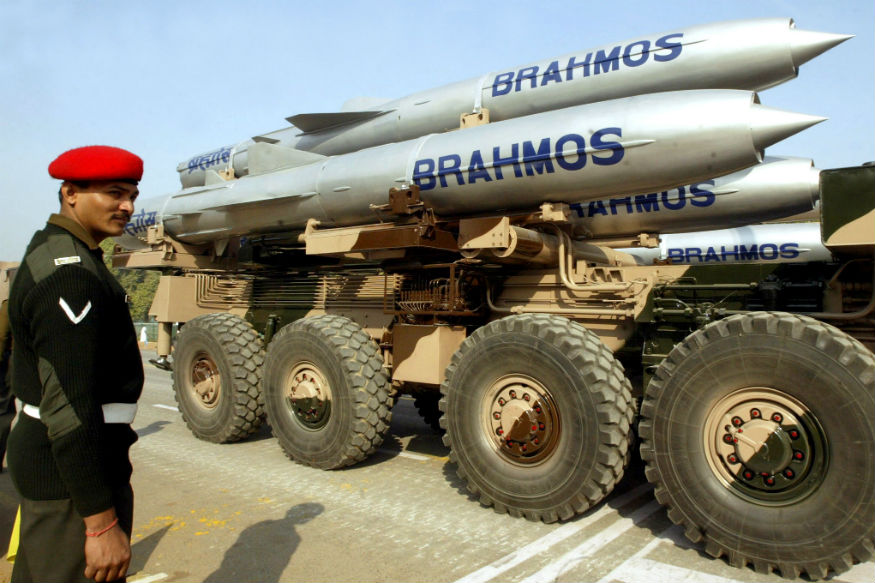INDIA’S SUPERSONIC 800KM BRAHMOS CRUISE MISSILES WILL ENSURE TOTAL PEACE ALONG THE HIMALYAS, THE IOR AND ALSO INDO PACIFIC

By
Colonel Awadhesh Kumar, Veteran Special Forces
In spite of the MTCR set up hastily in 1987 by few vested Western powers to ring fence India, the country achieved tremendous heights in the field of missile technology. Today India has not only achieved second strike capability in nuclear weapons through a variety of ballistic missiles but has also developed supersonic cruise missile.
With help of its supersonic BRAHMOS cruise missile, India has turned the tables on China. Till now China had been supplying missiles to Pakistan to cause pinpricks but now many countries in the Indo Pacific under threat of Chinese hegemony are showing keen interest in obtaining the Indian BRAHMOS missile.
The BRAHMOS capabilities are considerable and that is why they are considered quite invincible. With their deployment by India on land, sea and even with the Indian Air Force and now coupled with their export potential, the heat is being felt by China.
The 290 km BRAHMOS cruise missile was developed as a very stealthy, fast and extremely difficult to shoot down. The development began in the 1990s as a joint project between Russia and India to develop an Indian version of the Russian P-800 Oniks cruise missile. Being a joint project the missile’s name was kept on rivers Brahmaputra and Moskva in India and Russia, respectively.
Typically long range Cruise missiles are deployed and fired from long stand off ranges at their targets so as not to expose the launching platform to retaliation. The latest version of American Tomahawk cruise missile weighing roughly 1.3 tons has a range of over 1000km travelling at speed of 800 km per hour.
The BRAHMOS using a Ramjet in combination with an initial rocket propulsion maintains supersonic speed of 2.8 Mach all the way to the target. It is even faster than the Russian P800 even when weighing nearly 2.7 tons. Thus with speed of 3.5 times more and double the weight, it is far superior to even the Tomahawk ans several times deadlier. This Indian cruise missile also has the ability to maintain supersonic speeds while skimming at low altitude thus making it very difficult to detect and intercept. Finally it has an evasive “S-manoeuvre” ability shortly before impact, making it difficult to shoot down at close range, as a last ditch effort by the defender.
During the development phase the range of BRAHMOS was deliberately kept below 300km so as to protect the Russians from the shenanigans of the other members of the MTCR. Once developed and the first version fully deployed, India still kept the official range at very very precise 290 km, though every one understood that when fired in anger, it would shatter “the MTCR laid down range”.
India then concentrated on developing the sea version of thus cruise missile.Once these started getting deployed on Indian Naval platforms, the Indian Scientists moved on to develop the air launched version.
In June 2016, by now 34 membered MTCR had no choice left but to ironically invite India to become a member and India did to ensure that at least these counties do not supply any missiles to rouges. Also after joining the MTCR, India officially declared the range of BRAHMOS as 400 km, as it would not no more cause any embarrassment to Russia.
This missile thus extended its ability to destroy ground-based targets thru precision attacks against fixed installations such as radars, command centres, airbases and enemy missile batteries. The naval variants on naval platforms have eight-cell Vertical Launch System launchers with single or double launchers. Nearly all destroyers and frigates are now armed with these launchers and so will be the future ones.
The Navy has also successfully tested a submarine-launched version which is expected to enter service in future vessels. Submarine-launched BrahMos has additional ability to carry out launch from fairly close to the target without being detected.
Meanwhile carrying on with the air launched version, in December 2019, after a successful destruction of a naval target at sea by a BRAHMOS fired by a SU30 MKI, the integration was declared as operational. The 222 Sukhoi Squadron is now on its way to arm its fighters with these missiles. IAF plans to modify at least two squadrons of Sukhois for this purpose. It needs to be appreciated that IAF Sukhois have range of over 3000km with one aerial refueling and by launching the cruise missile at stand off range of 400km, will now have the ability to destroy targets at distance of over 3600km. By 2021,IAF should be arming its Sukhois with 800 km BRAHMOS missiles.
While missiles can be detected at longer ranges through AWACs aircraft, a ship would likely detect a sea-skimming missile at range of only thirty kilometres, affording the It only a thirty second time window to respond. Even an advanced Arleigh Burke-class destroyer, with its layered air defences, can at best handle in the best case Scenario, maximum of twelve BrahMos missiles at once. An entire carrier battle group would be saturated by more than sixty-four BRAHMOS missiles fired at it. So how will the Chinese Air Craft Carriers venturing into Indian Ocean defend themselves, if they dare to provoke the Indian Navy. In fact by the time Chinese Carrier Battle Group achieves the ability to operate far from its land bases, IAF will have the next generation version of BRAHMOS arming its Rafeals, Mirage 2000, MiG29s and even the Tejas fighters.
The Next Generation BRAHMOS being developed by India is not only smaller in size but weighs around only 1,3 tons and flies at Mach 3.5 speed. It also is much stealthier due to a very small Radar-Cross Section. It will soon be deployable from land, sea and air systems, including multiple missiles carried on all fourth-generation fighters.
Additionally, India is also working on its own scramjet-powered hypersonic missile capable of zipping along at Mach 7. These will be even harder to detect and shoot down and afford the targeted platforms just seconds to react. Even the U.S. military has only just begun development a hypersonic missile of its own.
Initially Chinese had hardly any reaction to development of BRAHMOS missiles by India not even when in 2007, India deployed its first operational regiment on the Western borders with Pakistan. However they suddenly got spooked when in response to their missile deployments in occupied Tibet, the Indian Army too began deployment of advanced BRAHMOS( BLOCK3 ) equipped regiment IN Arunachal Pradesh. These regiments have upto six batteries, each battery having around 4x launchers mounted on 12×12 trucks.
Since the new Block III missiles are designed to steep dive at seventy-degree angles to hit targets on the rear slopes of mountains, this has obviously made the Chinese quite worrisome. The deployment of 800km range BrahMos going deep into Tibet and even China when fired by the Sukhois is a big game changer. However China which is upset about the BrahMos missile’s presence on its border, probably should be more worried that India is announcing a deal for selling the weapon to Vietnam.
For long China’s close relationship with Pakistan, and its arming of Pakistan with even nuclear missiles was source of much irritation to India, as also the development of military base in Gwadhar, Pakistan—seen as an attempt to encircle India. Now it is turn of China to stop acting as a bully in seas off the Chinese Coast and Nautan Sea.
The Vietnamese Navy isn’t going to match China’s rapidly expanding flotilla any time soon. But small Vietnamese ships with BrahMos missiles could pose a major threat to China’s larger military vessel. Thus, if Vietnam does acquire the weapon, this would affect the balance of power in the Pacific. Other countries interested in the BRAHMOS include Malaysia, Brazil, Chile, Venezuela, South Africa and Indonesia and even some Middle East Countries.
So the Chinese have one major option that is to ensure de escalation along the Indo Tibetan border. The two major world powers instead of being adversaries would be better served by reciprocated détente. This will permit the Chinese to carry out peaceful trading within the Indian Ocean Region.
Simple! It can de-escalate the conflict with India. India is a democracy with all the messy internal political deliberations that implies—it’s not about to launch a massive surprise invasion of the Himalayas. A well-managed de-escalation wouldn’t have to carry a huge political cost. The average Chinese citizen likely doesn’t have strong feelings on the precise boundaries of the McMahon line.
Disputes over lightly populated Himalayan mountains shouldn’t constitute a truly substantive conflict of interest between the two countries—but they have been allowed to flourish into full blown military competition.



